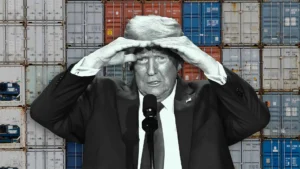The self-described tariff man may already be causing a rethink inside the C-suite about how much long-term capital is invested in building property, plants, and equipment — more formally known to investors as capital expenditures.
A new analysis of fourth quarter earnings reports from Goldman Sachs chief economist Jan Hatzius found that S&P 1500 companies hiked 2025 capital expenditure expectations by 5% sequentially. But the revision drops to only 2% for a basket of companies Goldman tracks with broad exposure to tariffs. Capital expenditure plans were revised down 1% for companies with a high reported share of sales to Canada, Mexico, and China.
Mentions of tariffs by management on earnings calls jumped well above levels seen during president Trump’s last trade war, Hatzius found.
“Company commentary highlighted the uncertainties introduced by tariff policy and their potential to delay or suspend investment decisions,” Hatzius said. “Companies with greater tariff exposure raised their inflation expectations disproportionately, though our aggregate tracker of price announcements only increased modestly on net and remained well within its pre-pandemic range.”

The Trump administration has flooded the zone with tariffs in the first few weeks in office.
Trump has pledged to put reciprocal tariffs into place pending an April 1 report from Commerce Secretary Howard Lutnick. The premise is that the US would raise its tariffs on foreign items to match what other countries slap on US products.
“For many years, the U.S. has been treated unfairly by other Countries, both friend and foe. This System will immediately bring Fairness and Prosperity back into the previously complex and unfair System of Trade. America has helped many Countries throughout the years, at great financial cost. It is now time that these Countries remember this, and treat us fairly — A LEVEL PLAYING FIELD FOR AMERICAN WORKERS,” Trump wrote in a weekend post on social media platform Truth Social.
The administration has already levied a 25% tariff on all imported steel.
The president has imposed a 10% tariff on all Chinese imports on top of existing tariffs on the country. China retaliated, placing tariffs on select chips and metals.
Trump recently agreed to pause 25% tariffs on Canada and Mexico for 30 days.
Hatzius thinks a further extension for Canada and Mexico tariffs is “likely” but expects tariffs on China to rise further. The veteran economist also expects new tariffs on EU autos and critical imports such as pharmaceuticals and semiconductors.
The markets have managed to shrug off tariff concerns as traders are of the view Trump is using them as a negotiating tactic. The Nasdaq Composite (^IXIC) and Dow Jones Industrial Average (^DJI) are up 2% and 1.2%, respectively, in February. The S&P 500 (^GSPC) is up modestly. Momentum stocks such as Nvidia (NVDA) and Palantir (PLTR) have rallied hard, with latter up 20% this month and the former up 43%.
Still, execs are beginning to get cautious about the Trump administration as uncertainty clouds their ability to plan while the costs of doing business rise.
“We’re not immune to this [tariffs] — we are less impacted than most of the businesses,” PepsiCo (PEP) chair and CEO Ramon Laguarta told me earlier this month.
“Obviously, we bring a lot of aluminum from Canada. We bring some oats from Canada as well, but [the] majority of our food — potatoes, corn — most of our inputs are localized. You know, we will be impacted. But we have enough flexibility — that’s why we’re giving conservative guidance now because we need some flexibility to deal with all this.”
________
Yahoo!finance









